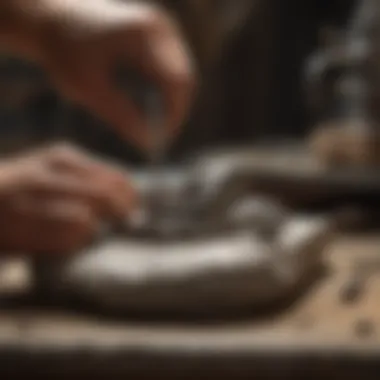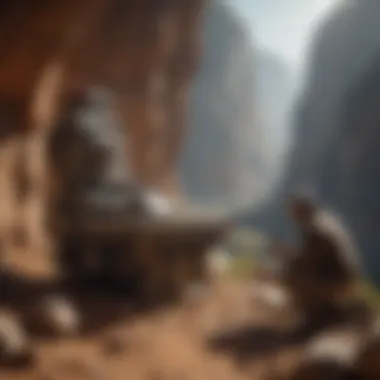Revolutionizing Rock Collecting: Unveiling the Stone Shaper Machine's Mastery


Rock and Fossil Identification
Rock and fossil identification is a crucial aspect of the fascinating world of rock collecting. It entails understanding the various types of rocks and fossils that one may encounter, each with its unique characteristics and features. Enthusiasts need to familiarize themselves with the tools used for identification, such as magnifying glasses, hardness picks, and streak plates, to accurately classify specimens.
Collecting Tips and Techniques
Effective collecting practices are vital to ensure a successful and fulfilling rock collecting experience. Enthusiasts should adhere to best practices, such as obtaining permission before collecting at sites, respecting nature, and recording important details about the specimens and their locations. Locating prime collecting sites involves research and exploration to identify areas rich in geological wonders. Safely extracting specimens requires precision tools like chisels, brushes, and protective gear to avoid damaging the rocks.
Preservation and Display
Preservation techniques are essential for maintaining the integrity of collected rocks and fossils. Methods like cleaning with gentle brushes and water, stabilizing fragile specimens, and storing them in a climate-controlled environment help prevent deterioration. Proper storage methods include using acid-free containers, organizing specimens by type or location, and labeling them accurately for easy identification. Creative display ideas allow collectors to showcase their treasures aesthetically, utilizing shadow boxes, special lighting, and information cards to highlight the significance of each specimen.
Geological Insights
Delving into geological insights sheds light on the origins and evolution of rocks and fossils. Understanding geological formations and processes helps collectors appreciate the forces shaping our planet over millions of years. Exploring the historical significance of rocks and fossils uncovers connections to past civilizations, climatic changes, and extinction events. Notable discoveries in the field, from dinosaur fossils to rare gemstones, provide valuable insights into Earth's history and the ever-evolving field of geology.
Introduction
The introduction sets the stage for the exploration of the stone shaper machine, a revolutionary technology reshaping the realm of rock collecting. This article aims to delve deep into the intricate workings and transformative impact of this cutting-edge machine on how enthusiasts engage with geological specimens. By shedding light on the inception and functionality of the stone shaper machine, readers will gain a comprehensive understanding of its significance in revolutionizing rock collecting.
Understanding the Stone Shaper Machine
Origins of the Machine
The origins of the stone shaper machine trace back to its innovative roots, where centuries-old techniques merged with modern advancements to create a pioneering tool for rock enthusiasts. One key characteristic of the machine's origins lies in its ability to amalgamate traditional craftsmanship with digital precision, offering collectors a blend of heritage and cutting-edge technology. The unique feature of these origins lies in the preservation of artisanal techniques while enhancing efficiency, making it a popular choice for those seeking a balance between tradition and innovation.
The machine's origins bring forth advantages such as increased productivity and refined aesthetics, catering to a diverse audience of rock collectors looking for both authenticity and high-quality results in their specimens.


Purpose and Functionality
The purpose and functionality of the stone shaper machine go beyond mere cutting and shaping; it heralds a new era of precision and customization in rock collecting. With its advanced capabilities, this machine offers collectors unparalleled control over the design and composition of their specimens, elevating the crafting process to new heights. A key characteristic of the machine's functionality is its seamless integration of digital tools, enabling users to translate intricate designs into tangible geological forms with exceptional accuracy.
The unique feature of its functionality lies in its ability to cater to a wide range of artistic visions and geological experiments, making it a versatile and sought-after choice for enthusiasts seeking boundless creativity in their collections. Despite some intricacies in mastering its full potential, the advantages of using the stone shaper machine far outweigh any challenges, as it opens up a world of possibilities for collectors striving for excellence in their creations.
Evolution of Rock Collecting
Traditional Methods vs. Modern Technology
The evolution of rock collecting juxtaposes traditional methods with state-of-the-art technology, highlighting a shift in how enthusiasts approach and interact with geological specimens. This contrast underscores the benefits and limitations of each approach, shedding light on the dual nature of the collecting community's practices. One key characteristic of this evolution is the coexistence of age-old techniques with cutting-edge innovations, offering collectors a spectrum of choices in their pursuit of geological treasures.
The unique feature of this comparison lies in the fusion of tradition and modernity, presenting collectors with a nuanced understanding of the evolving landscape of rock collecting. While traditional methods evoke nostalgia and craftsmanship, modern technology introduces efficiency and precision, creating a harmonious balance in the collector's toolkit.
Impact on the Collecting Community
The impact of modern technology on the collecting community resonates deeply, signaling a transformative wave that shapes how enthusiasts engage with and appreciate geological specimens. This impact manifests in various forms, from enhancing accessibility and convenience to fostering a sense of community and collaboration among collectors. A key characteristic of this impact is the democratization of knowledge and resources through digital platforms, empowering enthusiasts to share insights and discoveries on a global scale.
The unique feature of this impact lies in its ability to bridge gaps between seasoned collectors and newcomers, fostering a supportive environment for knowledge exchange and innovation within the community. While there are challenges such as adapting to digital interfaces and technological advancements, the advantages of this impact are evident in the enriched experiences and connections forged among collectors worldwide.
The Technology Behind the Machine
In this section of the article, we delve into the pivotal role played by the technology behind the Stone Shaper Machine. The significance of understanding the intricate workings of this cutting-edge technology cannot be overstated. By exploring the specific elements, benefits, and considerations of the technology, we can truly grasp how it has revolutionized rock collecting.
Precision Engineering
Innovative Cutting Techniques:


Innovative Cutting Techniques form the backbone of the Stone Shaper Machine, redefining how enthusiasts interact with geological specimens. The key characteristic of these techniques lies in their ability to intricately shape and carve rocks with unparalleled precision. This level of precision is a game-changer in the rock collecting realm, offering a vast array of design possibilities that were once unattainable. One unique feature of Innovative Cutting Techniques is their versatility, allowing for the customization of rock specimens with unparalleled accuracy. While the advantage of precision is clear, some may argue that these techniques require a steep learning curve for mastery.
Integration of Digital Tools:
The Integration of Digital Tools within the Stone Shaper Machine elevates its functionality to new heights. A key characteristic of this integration is the seamless connection between software and hardware, enabling precise control over the cutting process. This choice proves beneficial as it eliminates the margin of error present in manual operations, ensuring consistent and high-quality results. One unique feature of this integration is the real-time feedback it provides, allowing users to adjust parameters on the fly. While the advantages are undeniable in terms of efficiency and accuracy, some may perceive a potential disadvantage in terms of over-reliance on technology.
Advanced Software Integration
Automation and Customization Features:
The Automation and Customization Features embedded in the Stone Shaper Machine redefine convenience and precision in rock collecting. The key characteristic of these features is their ability to automate complex cutting sequences, streamlining the overall collection process. This choice is beneficial as it reduces human error and enhances the efficiency of specimen preparation. One unique feature of this automation is its adaptability, catering to a wide range of cutting requirements with minimal user input. While the advantages in terms of time-saving and precision are evident, some collectors may express concerns about the potential loss of hands-on craftsmanship.
Enhancing User Experience:
Enhancing User Experience is at the core of the Stone Shaper Machine's design philosophy. The key characteristic of this enhancement is the seamless interaction between users and the machine, creating a user-friendly environment. This choice is beneficial as it allows enthusiasts of all levels to explore the machine's capabilities with ease. One unique feature is the personalized settings that cater to individual preferences, offering a tailored experience for every user. While the advantages in terms of accessibility and customization are undeniable, some purists may view this level of automation as detracting from the traditional rock collecting experience.
Benefits of Utilizing the Stone Shaper Machine
In the realm of rock collecting, the Stone Shaper Machine stands out as a game-changer, offering a myriad of advantages that elevate the entire experience. By leveraging this cutting-edge technology, enthusiasts can delve deeper into the world of geological specimens, uncovering hidden intricacies with unparalleled efficiency and precision. This section will elaborate on the pivotal role that the Stone Shaper Machine plays in transforming traditional rock collecting practices into a streamlined and innovative process.
Efficiency and Precision
Streamlined Collection Processing
Streamlined Collection Processing is not just a buzzword but a fundamental aspect of the Stone Shaper Machine's efficacy. This feature revolutionizes how rocks are collected, processed, and transformed. The seamless integration of automated functions ensures that every step, from selection to shaping, is optimized for speed and accuracy. Enthusiasts can now expedite their collection process without sacrificing quality or intricacy. The Stone Shaper Machine's ability to streamline collection processing sets a new standard in the world of rock collecting, marking a shift towards enhanced productivity and precision.
Consistent Quality Output


Consistent Quality Output is the hallmark of the Stone Shaper Machine, guaranteeing enthusiasts exceptional results every time. The machine's precision engineering and state-of-the-art cutting techniques ensure that the output is uniform, flawlessly capturing the essence of each geological specimen. With attention to detail and meticulous craftsmanship, the Stone Shaper Machine delivers consistent quality output that exceeds expectations. Enthusiasts can rely on this technology to uphold the integrity of their collections, showcasing the beauty of geological forms in a consistent and captivating manner.
Enhanced Creativity and Exploration
Unlocking New Design Possibilities
Unlocking New Design Possibilities through the Stone Shaper Machine opens a world of creative freedom for collectors. By breaking traditional constraints, enthusiasts can explore unconventional shapes and forms, pushing the boundaries of design in rock collecting. This feature enables collectors to unleash their creativity, infusing a unique artistic touch into their collections. The Stone Shaper Machine serves as a catalyst for innovation, inviting enthusiasts to experiment and envision new possibilities in the realm of geological specimens.
Experimentation with Geological Forms
Experimentation with Geological Forms empowers collectors to engage in a profound exploration of the earth's diverse structures. With the ability to experiment and manipulate geological forms, enthusiasts can study and appreciate the intricacies of different rock compositions. This aspect encourages collectors to think beyond the conventional and embrace the complexities of nature through hands-on exploration. The Stone Shaper Machine not only facilitates experimentation but also enriches the collecting experience, offering a dynamic platform for enthusiasts to interact with and learn from geological forms.
Implications for the Collecting Community
The "Implications for the Collecting Community" section within this article holds significant importance as it delves into how the adoption of the Stone Shaper Machine impacts enthusiasts and the larger collecting community. By focusing on the specific elements, benefits, and considerations related to this topic, readers gain a profound understanding of the shift occurring in rock collecting practices.
Educational Advancements
Learning Opportunities for Enthusiasts
Exploring the realm of Learning Opportunities for Enthusiasts opens avenues for individuals to engage with geological specimens in a structured and informative manner. This aspect contributes to the overall goal of enhancing knowledge and skills within the collecting community. The key characteristic of these opportunities lies in their hands-on approach, allowing enthusiasts to interact directly with rocks and fossils, thereby deepening their understanding of geology. The unique feature of Learning Opportunities for Enthusiasts is the practical application of theoretical concepts, bridging the gap between classroom learning and real-world specimen examination. While these opportunities provide valuable experiential learning, there may be challenges related to accessibility and resource availability that need to be considered in this context.
Integration into Geology Curricula
Integrating the Stone Shaper Machine into Geology Curricula aims to enrich academic programs by incorporating innovative technology into the study of rocks and minerals. This integration proves to be a beneficial choice for the article as it enhances the educational value of traditional geology courses. The key characteristic of this integration is the seamless blending of theoretical teachings with hands-on experience using the machine, offering students a comprehensive understanding of geological principles. The unique feature lies in the machine's ability to simulate real-world geological processes in a controlled environment, providing students with a practical tool for experimentation. While the integration presents numerous advantages in terms of enhancing student engagement and learning outcomes, there may be challenges regarding faculty training and equipment maintenance that require careful consideration.
Environmental Considerations
Sustainable Practices
The discussion on Sustainable Practices within the context of the Stone Shaper Machine underscores the importance of environmentally friendly approaches in rock collecting. By highlighting how these practices contribute to the overall goal of sustainability, readers glimpse the significance of responsible resource management in geological specimen extraction. The key characteristic of Sustainable Practices lies in their emphasis on minimizing environmental impact while maximizing specimen utilization, making them a popular choice for this article. The unique feature of these practices is their potential to set a precedent for ethical collection standards, promoting long-term conservation efforts within the collecting community. Despite the clear advantages these practices offer in terms of ecological preservation and community goodwill, challenges related to cost-effectiveness and implementation logistics must be addressed to ensure widespread adoption.
Waste Reduction Strategies
Exploring Waste Reduction Strategies in conjunction with the Stone Shaper Machine unveils proactive approaches to minimizing waste generation and promoting sustainable rock collecting practices. By shedding light on how these strategies align with the overall goal of reducing environmental footprint, readers grasp the importance of responsible waste management in geological specimen processing. The key characteristic of Waste Reduction Strategies is their focus on optimizing resource utilization while minimizing wastage, positioning them as a beneficial choice for this article's discussion. The unique feature of these strategies lies in their potential to foster a culture of conservation and efficiency, encouraging enthusiasts to rethink their approach to rock collecting. Despite the evident advantages these strategies bring in terms of environmental conservation and operational efficiency, challenges relating to implementation complexity and industry buy-in may present hurdles that need to be navigated for successful integration.







